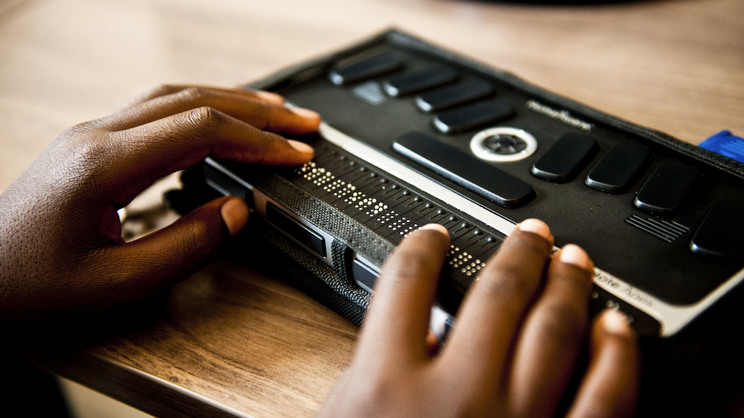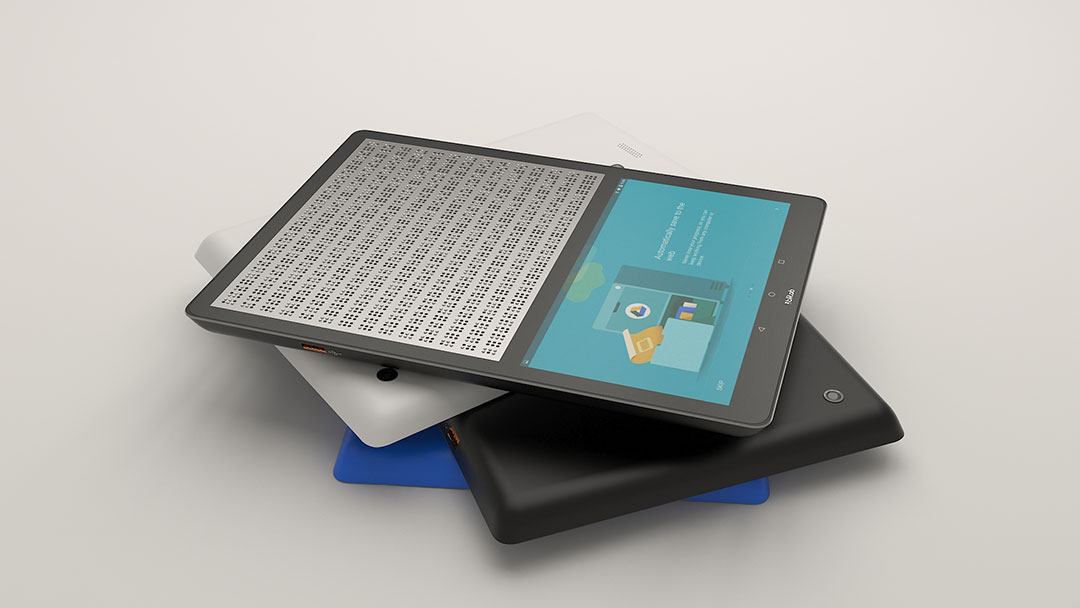Discover Innovative Tools Designed for the Visually Damaged
The growth of cutting-edge tools for the visually damaged represents a substantial improvement in access and independence. Technologies such as wise glasses with AI capacities and mobile applications made to supply auditory summaries are improving day-to-day experiences for customers. Additionally, wearable devices that employ haptic comments boost ecological awareness, while modern-day Braille advancements supply new ways to involve with message. As these tools continue to advance, their effect on the lives of those with aesthetic impairments elevates crucial concerns about the future of inclusivity and autonomy in various elements of life. What exists ahead in this technological landscape?
Smart Glasses for Navigating

Smart glasses made for navigation are transforming the means visually damaged people connect with their environment. These advanced tools utilize a mix of cam modern technology, expert system, and acoustic comments to offer real-time info about surroundings. By using barrier discovery systems, clever glasses can alert individuals to potential risks, enabling safer mobility in both unknown and acquainted settings.
The integration of GPS technology better boosts navigating abilities, allowing customers to receive auditory directions as they relocate. This hands-free method not only promotes independence yet additionally equips aesthetically damaged individuals to browse urban landscapes with boosted self-confidence. Furthermore, lots of smart glasses are geared up with functions that identify sites and road signs, supplying contextual info that boosts the individual experience.
Moreover, the advancement of these devices is constantly progressing, with companies working to improve the precision of things acknowledgment and increase the range of navigational functions. As clever glasses come to be a lot more economical and obtainable, they hold the potential to substantially change day-to-day life for aesthetically damaged users. Ultimately, these ingenious tools represent a vital step toward inclusivity, offering boosted movement and a better sense of autonomy for people browsing the world around them.

Mobile Apps for Daily Living
Just how can mobile applications enhance the every day lives of visually damaged individuals? Mobile applications are reinventing the method aesthetically damaged customers navigate their environments, take care of daily tasks, and gain access to details. These applications provide important support through different capabilities, promoting self-reliance and boosting lifestyle.
Numerous cutting-edge mobile applications are made specifically for daily living. Applications like Be My Eyes attach visually damaged individuals with sighted volunteers via video clip calls, enabling them to obtain real-time aid with tasks such as reading tags or navigating unfamiliar rooms. Seeing AI, created by Microsoft, uses fabricated intelligence to describe environments, reviewed message, and recognize items, properly changing a smartphone into a powerful tool for everyday assistance.
Furthermore, navigating applications customized for the aesthetically impaired, such as Aira and BlindSquare, supply audio-based instructions and environmental information, allowing users to traverse their environments safely and with confidence. Beyond navigating and prompt help, mobile applications likewise sustain company and task management, with attributes that aid individuals establish reminders, produce order of business, and track consultations. In summary, mobile applications act as vital resources, empowering aesthetically damaged individuals to lead even more independent and satisfying lives.
Wearable Technologies for Assistance
Empowerment through innovation go right here is progressively noticeable in the realm of wearable gadgets designed to help aesthetically damaged people. These cutting-edge devices incorporate seamlessly right into life, boosting navigating and giving vital responses to users. Clever glasses geared up with electronic cameras can check out and recognize faces text out loud, permitting customers to communicate more with confidence in social and specialist settings.
One more notable innovation is the usage of haptic responses systems in wearable gadgets. These systems utilize vibrations or various other tactile signals to convey information concerning the user's environment, such as challenges or changes in surface, boosting mobility and safety and security. Wearable innovations additionally include wristbands that attach to smart devices, alerting individuals to notices via subtle vibrations, thus enhancing connectivity without reliance on visual signs.
As these modern technologies proceed to progress, they are not just enhancing self-reliance for aesthetically damaged people but also promoting a greater feeling of inclusion in culture. By connecting the space between difficulties encountered in everyday living and the potential for freedom, wearable technologies offer as pivotal devices in the quest for equality and empowerment for those with aesthetic disabilities.
Sound Summary Tools
Sound description tools play a vital duty in enhancing ease of access for visually impaired people, supplying them with the capacity to engage with aesthetic media. OCR devices for the blind. These tools offer narrated summaries of key visual elements in movies, tv shows, and live performances, ensuring that individuals can fully comprehend the context and feelings communicated through visuals
Sound description can be incorporated into numerous platforms, including streaming services, movie theater testings, and live cinema. Lots of preferred streaming services now consist of audio summary as an access attribute, allowing customers to choose it conveniently. Along with mainstream media, specialized apps likewise exist, giving audio go right here descriptions for art exhibits, museums, and other cultural events.
The efficiency of audio summary depends upon the skill of the narrators, who need to communicate visual details succinctly without diminishing the original sound. Advancements in this area are also leading the way for more personalized experiences, where individuals can adjust the degree of information and pacing according to their choices.
Braille Innovations and Tools
Braille gadgets and technologies have dramatically transformed the way aesthetically damaged individuals interact with text and information. Modern developments have actually resulted in the advancement of versatile devices that boost literacy and freedom amongst individuals. Notably, Braille show modern technologies have actually developed, enabling vibrant analysis experiences. These gadgets convert digital message right into Braille, allowing users to access a large array of info on tablets, computer systems, and mobile phones.
In addition, mobile Braille notetakers incorporate standard Braille input with modern-day functionalities, assisting in note-taking, scheduling, and file modifying on the move. Braille displays and notetakers. These compact tools frequently include text-to-speech capabilities, bridging the space between Braille and acoustic info
On top of that, ingenious Braille printers have actually emerged, enabling users to create Braille tags, documents, and instructional materials successfully. This accessibility promotes higher engagement in expert and instructional environments, ultimately promoting inclusivity.
In addition, study into clever Braille innovations proceeds to expand. Gadgets that integrate expert system are being checked out to supply real-time navigating help and contextual info, boosting the individual experience in diverse settings. Overall, these advancements mirror a commitment to check this empowering visually damaged people via innovation, ensuring they can quickly gain access to and involve with the world around them.

Final Thought
The development of cutting-edge devices for the aesthetically damaged substantially boosts self-reliance and top quality of life. These technologies not only foster greater addition but also advertise autonomy in everyday tasks, ultimately adding to an extra equitable and available culture for visually impaired people.
As clever glasses become a lot more budget-friendly and obtainable, they hold the potential to dramatically transform everyday life for visually damaged users. Mobile applications are transforming the means aesthetically impaired individuals browse their atmospheres, take care of everyday jobs, and access information. Applications like Be My Eyes connect visually impaired individuals with sighted volunteers via video phone calls, enabling them to obtain real-time assistance with tasks such as reading labels or navigating strange rooms.In addition, navigating applications tailored for the visually impaired, such as Aira and BlindSquare, supply audio-based instructions and ecological info, allowing individuals to traverse their environments securely and confidently.The innovation of ingenious devices for the aesthetically damaged dramatically boosts freedom and quality of life.
Comments on “Mobility Aids for Visually Impaired Users: Navigating the World with Confidence”